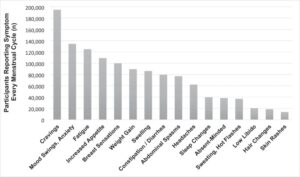“About 80% of women report having experienced at least one physical or moral premenstrual symptom. However, data are limited on the onset of PMS symptoms across countries and by age group. “
Gynecological health, an important issue that concerns a large part of the population… but always the last wheel of the carriage when it comes to scientific research.
Fortunately, a study conducted by American universities and published in the summer of 2022 tends to show the extent of a phenomenon we know all too well: premenstrual syndrome (PMS). Highlighted in The world this week was conducted globally, between May 2017 and June 2020, in 140 countries.
It was thanks to the Flo menstrual monitoring application that more than 238,000 people were able to be questioned their experience with PMS and how it can affect their physical, mental and daily health.
Food cravings, largely in charge of premenstrual symptoms
Among the symptoms most frequently reported during this period preceding menstruation and the onset of a new cycle, we find it largely food cravings (at 85.28%), mood swings and anxiety (at 64.18%), as well as tiredness (at 57.3%). Then there is an increase in appetite, breast tenderness, weight gain or a feeling of bloating.

Examined by age group (18-27, 28-37, 38-47 and 48-55), the results also show that the presence of some symptoms can vary with age:
“We found that the frequency of symptoms increases with age due to distraction, decreased libido, sleep disturbances, gastrointestinal symptoms, weight gain, migraines, hot flashes, fatigue, bloating. Conversely, the frequency of abdominal spasms decreases. with age. “
Other important data: 28.61% of respondents say that the symptoms they experience interfere with their daily life during each cycle.

Unequal to take with tweezers
In which countries are premenstrual symptoms reported most frequently?
In first place are Egypt, Lebanon and Brazil, while at the bottom of the ranking there are Mali, Gabon and Togo.
According to the study, PMS has a much lower prevalence rate in European countries than in Asian countries. But depending on the country, the difficulty felt is not necessarily the same. “People from the UK, Brazil, Japan, Korea and Australia report more intense and longer premenstrual symptoms, while Hong Kong and Pakistan do not. “
The study authors acknowledge the possibility of bias according to the interviewees : “It is possible that people who are more aware of PMS symptoms are more likely to use an app to track them, or more likely to complete a survey focused on PMS symptoms.”
Photo credit: Sora Shimazaki via Pexels
More articles on
Rules
-
66% of women are in favor of menstrual leave … but in practice it is far from obvious
-
On TikTok, people use cycle blood to make face masks and … It’s debatable
-
How do we talk about menstruation abroad? Reply in this Courrier International podcast
-
A chilling study denounces the danger of cycle tracking apps for our personal data
-
Menstrual Products Go Free In Scotland! When will France be?
-
A new study claims that the Covid vaccine would have (mild) effects on menstruation
-
Menstruation would cause you to lose 5 months of sleep, according to this chilling menstruation study
Source: Madmoizelle
Ashley Root is an author and celebrity journalist who writes for The Fashion Vibes. With a keen eye for all things celebrity, Ashley is always up-to-date on the latest gossip and trends in the world of entertainment.


.png)

